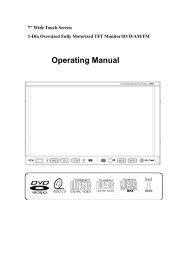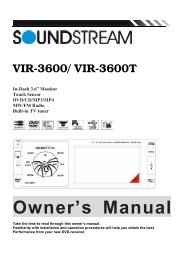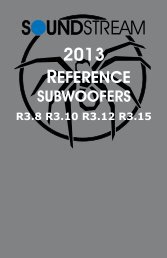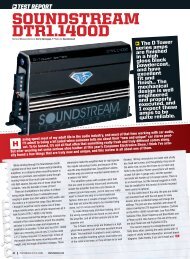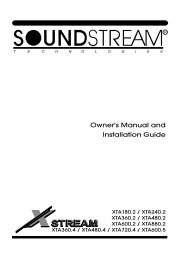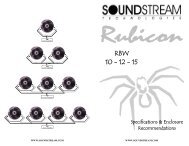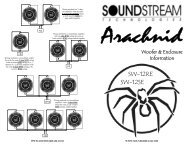pcx anolog series manual - Soundstream
pcx anolog series manual - Soundstream
pcx anolog series manual - Soundstream
Create successful ePaper yourself
Turn your PDF publications into a flip-book with our unique Google optimized e-Paper software.
OWNER'S MANUAL<br />
PCX2.180 / 2.270/ 2.350 / 2.440 / 2.540 / 2.700<br />
PCX4.240 / 4.360 / 4.540<br />
PCX5.600
TABLE OF CONTENTS<br />
INTRODUCTION................................................................. 2<br />
TABLE OF CONTENTS<br />
FEATURES & SPECIFICATIONS.............................................<br />
3<br />
CONTROLS & FUNCTIONS...................................................<br />
4 ~ 8<br />
PLANNING & MOUNTING YOUR SYSTEM................................ 9 ~10<br />
WIRING DIAGRAM.............................................................. 11<br />
ADJUSTING & TUNING........................................................ 12<br />
TROUBLE SHOOTING.......................................................... 13
INTRODUCTION<br />
INTRODUCTION<br />
Amplifier's provide high-performance sound reinforcement for you'r<br />
mobile audio equipment. The Multi-Mode bridging capabilities allow<br />
flexibility in hosting several different speaker configurations.<br />
To achieve optimum performance, it is highly recommended that you read<br />
this Owners Manual before beginning installation.<br />
2
FEATURES<br />
IDI (Intelligent Distress Indicator)gives a visual<br />
indication of the amplifier's protection status<br />
Fully regulated MOSFET power supply<br />
PWM circuitry<br />
Tri-guard amplifier protection<br />
Platinum RCA inputs and outputs<br />
Bi-linear selectable crossovers for inputs and outputs (Hi/Full/Low)<br />
Continuously variable high and low-pass crossovers<br />
Subwoofer equalizer control switch<br />
Viable phase shift control (0 - 180 degree)<br />
OEM floating ground input<br />
Platinum 4-gauge power connectors<br />
Tri-mode operation<br />
Includes remote bass boost control (PCX2.350/2.440/2.540/2.700/5.600)<br />
FEATURES & SPECIFICATIONS<br />
SPECIFICATIONS<br />
(BRIDGE)<br />
MODEL CHANNEL RMS @ 4 OHM @ 2 OHM @ 4 OHM FUSES DIMENSIONS<br />
PCX2.180<br />
2<br />
60W x 2CH<br />
90W x 2CH<br />
180W x 1CH<br />
30A X 1<br />
11.8"x2.5"x9.9"<br />
PCX2.270<br />
2<br />
80W x 2CH<br />
135W x 2CH<br />
175W x 1CH<br />
40A X 1<br />
13.8"x2.5"x9.9"<br />
PCX2.350<br />
2<br />
110W x 2CH<br />
175W x 2CH<br />
350W x 1CH<br />
20A X 2<br />
15.7"x2.5"x9.9"<br />
PCX2.440<br />
2<br />
150W x 2CH<br />
220W x 2CH<br />
440W x 1CH<br />
30A X 2<br />
17.7"x2.5"x9.9"<br />
PCX2.540<br />
2<br />
180W x 2CH<br />
270W x 2CH<br />
540W x 1CH<br />
25A X 3<br />
21.7"x2.5"x9.9"<br />
PCX2.700<br />
2<br />
220W x 2CH<br />
350W x 2CH<br />
700W x 1CH<br />
30A X 3<br />
23.6"x2.5"x9.9"<br />
PCX4.240<br />
4<br />
40W x 4CH<br />
60W x 4CH<br />
120W x 2CH<br />
20A X 2<br />
14.9"x2.5"x9.9"<br />
PCX4.360<br />
4<br />
60W x 4CH<br />
90W x 4CH<br />
180W x 2CH<br />
25A X 2<br />
16.5"x2.5"x9.9"<br />
PCX4.540<br />
4<br />
80W x 4CH<br />
135W x 4CH<br />
270W x 2CH<br />
20A X 3<br />
18.9"x2.5"x9.9"<br />
PCX5.600<br />
5<br />
60W x 4CH +<br />
90W x 4CH + 180W x 2CH +<br />
40A X 2<br />
25.2."x2.5"x9.9"<br />
175W x 1CH<br />
240W x 1CH<br />
240W x 1CH<br />
3
CONTROLS & FUNCTIONS<br />
Controls & Functions<br />
PCX2.180 / 2.270 / 2.350 / 2.440 / 2.540 / 2.700<br />
4 6 5 14 3 2 1 7 8 9<br />
PHASE<br />
0 180<br />
CROSS<br />
OVER<br />
FULL<br />
HIGH<br />
LOW<br />
HIGH<br />
PASS<br />
50 500<br />
(Hz)<br />
REMOTE<br />
BASS<br />
BOOST<br />
LOW<br />
PASS<br />
2 Channel High Power Mosfet Amplifier<br />
LEVEL<br />
150<br />
0 50 MIN MAX<br />
(Hz)<br />
INPUTS<br />
L<br />
R<br />
LINE OUT<br />
POWER<br />
PROTECTION<br />
Picasso<br />
FUSES<br />
POWER<br />
L<br />
SPEAKER<br />
L R R<br />
BATT REM GND<br />
2 Channel High Power Mosfet Amplifier<br />
B/D<br />
Picasso<br />
10 11 12<br />
13<br />
PCX4.240 / 4.360 / 4.540<br />
14 6 2 5 7 8 5 2 6 9<br />
fuse<br />
PCX2.180 : 30A X 1<br />
PCX2.270 : 40A X 1<br />
PCX2.350 : 20A X 2<br />
PCX2.440 : 30A X 2<br />
PCX2.540 : 25A X 3<br />
PCX2.700 : 30A X 3<br />
REMOTE<br />
FULL<br />
LOW LOW HIGH INPUTS LINE OUT<br />
HIGH PASS PASS CH3 CH1 CH1<br />
HIGH<br />
PASS<br />
LOW<br />
PASS<br />
4 Channel High Power<br />
HIGH<br />
LOW<br />
Mosfet Amplifier<br />
FULL<br />
POWER<br />
CROSS<br />
OVER<br />
50 150<br />
(Hz)<br />
50 500<br />
(Hz)<br />
50 500<br />
(Hz)<br />
50 150<br />
(Hz)<br />
CROSS<br />
OVER<br />
PROTECTION<br />
Picasso<br />
CH3/4<br />
0 180<br />
PHASE<br />
0<br />
BASS<br />
BOOST<br />
MIN<br />
MAX<br />
LEVEL<br />
CH4<br />
CH2<br />
CH2<br />
MIN<br />
MAX<br />
LEVEL<br />
0<br />
BASS<br />
BOOST<br />
0 180<br />
PHASE<br />
CH1/2<br />
4<br />
3<br />
1<br />
1<br />
3<br />
4<br />
FUSES<br />
POWER<br />
CH1<br />
SPEAKER<br />
CH2 CH3 CH4<br />
Picasso<br />
CH1<br />
CH2 CH3 CH4<br />
BATT REM GND<br />
B/D<br />
B/D<br />
4<br />
10 11 12 13<br />
fuse<br />
PCX4.240 : 20A X 2<br />
PCX4.360 : 25A X 2<br />
PCX4.540 : 20A X 3
Controls & Functions<br />
PCX5.600<br />
CH1<br />
7 5 7 5 7 1<br />
2<br />
INPUTS<br />
HIGH<br />
PASS<br />
50 500<br />
(Hz)<br />
INPUTS<br />
CH3<br />
HIGH<br />
PASS<br />
50 500<br />
(Hz)<br />
CH5<br />
CH2<br />
MIN MAX<br />
CH4 MIN MAX CH5<br />
LEVEL<br />
LEVEL<br />
CH 1/2<br />
CH 3/4<br />
CH 5<br />
INPUTS<br />
L<br />
R<br />
LEVEL<br />
MIN<br />
MAX<br />
MODE<br />
RCA<br />
FREQ<br />
25 160<br />
(Hz)<br />
MIN<br />
MAX<br />
LEVEL<br />
LOW<br />
PASS<br />
50 150<br />
(Hz)<br />
0 180<br />
PHASE<br />
9<br />
5 Channel High Power<br />
Mosfet Amplifier<br />
0<br />
PWR<br />
PROT<br />
BASS<br />
BOOST<br />
REMOTE<br />
Picasso<br />
CONTROLS & FUNCTIONS<br />
1 1<br />
15<br />
1<br />
4<br />
3<br />
14<br />
FUSES<br />
POWER<br />
CH1<br />
SPEAKER<br />
CH2 CH3 CH4 CH5<br />
Picasso<br />
CH1<br />
CH2 CH3 CH4 CH5<br />
BATT REM GND<br />
B/D<br />
B/D<br />
fuse<br />
10 11 12<br />
13<br />
PCX5.600 : 40A X 2<br />
5
Controls & Functions<br />
CONTROLS & FUNCTIONS<br />
1. Input Level Adjustment<br />
LEVEL<br />
MIN<br />
MAX<br />
This control adjusts the amplifier's input sensitivity. Input sensitivity is variable from<br />
200 Millivolts to 8 volts. Clockwise increases sensitivity. Counterclockwise decreases<br />
sensitivity. The amplifier can be driven to full power with a wide range of signal levels.<br />
A lower signal level will require increased sensitivity for full power. A higher signal level<br />
will require decreased sensitivity. Avoid setting sensitivity lower than necessary as this<br />
would introduce unwanted distortion.<br />
2. Low Pass Filter Control<br />
LOW<br />
PASS<br />
50 150<br />
(Hz)<br />
This control is used to set the desired low pass frequency (50 ~ 150HZ).<br />
The filter acts to cut-off frequencies above the set-point. In general, the selected<br />
frequency should closely match the resonant frequency of the speaker box.<br />
3. Bass Boost Control<br />
BASS<br />
BOOST<br />
0 +18<br />
By using the bass boost function, bass notes at 35Hz - 80Hz are emphasized as much<br />
as 18dB.<br />
4. Phase Shift Control<br />
PHASE<br />
0<br />
180<br />
PHASE SHIFT SWITCH (0 AND 180 DEGREES):<br />
Allows you to change the phase of your subwoofer from 0 to 180 degrees to help<br />
compensate for timing differences between drivers.<br />
6
Controls & Functions<br />
5. Subsonic Filter Control<br />
SUB<br />
SONIC<br />
15 40<br />
(Hz)<br />
Variable Subsonic Filter (15Hz - 40Hz) :<br />
The Subsonic filter will roll off all of the unwanted frequencies below 15Hz - 40Hz.<br />
This will allow the amplifier to use that wasted power on the audible bandwidth.<br />
CONTROLS & FUNCTIONS<br />
6. Cross over Switch<br />
CROSS<br />
OVER<br />
FULL<br />
HIGH<br />
LOW<br />
Adjust the crossover for your chosen installation method.<br />
LOW: Low pass filter-only bass tones(50Hz-150Hz)go to speakers. Use with woofer or subwoofer.<br />
FULL: No filter-all tones go to speakers. Use with full-range speakers, or with external<br />
crossovers. HIGH: High pass filter-blocks very low tones(50Hz-600Hz)from the speakers.<br />
7. Low Level Input RCA jacks<br />
INPUTS<br />
LINE OUT INPUTS<br />
CH3 CH1<br />
L<br />
INPUTS INPUTS INPUTS<br />
L<br />
R<br />
PCX2.180/2.270/2.350/2.440/<br />
PCX2.540/2.700<br />
CH4<br />
CH2<br />
PCX4.240 / 4.360 / 4.540<br />
CH 1/2<br />
CH 3/4 CH 5<br />
PCX5.600<br />
These inputs are for signal cables from the source. Always use high quality shielded<br />
RCA cables.<br />
R<br />
8. Low Level OUT RCA jacks<br />
INPUTS<br />
LINE OUT INPUTS<br />
CH3 CH1<br />
L<br />
INPUTS INPUTS INPUTS<br />
L<br />
R<br />
PCX2.180/2.270/2.350/2.440/<br />
PCX2.540/2.700<br />
CH4<br />
CH2<br />
PCX4.240 / 4.360 / 4.540<br />
CH 1/2<br />
CH 3/4 CH 5<br />
PCX5.600<br />
The LINE OUT allows you to build multiple amplifier systems without having to use splitter<br />
cords to distribute the signal. Now it is simply a matter of bringing one set of RCAS into<br />
the first amplifier, then using the line out RCA jacks as the feed to the next amplifier.<br />
R<br />
7
Controls & Functions<br />
CONTROLS & FUNCTIONS<br />
9. LED Indicator<br />
PWR<br />
PWR(Power): This GREEN LED will illuminate when the amplifier is turned "ON".<br />
If it fails to illuminate, check the power connections to the Amplifier and fuses.<br />
PROT<br />
PROT(Protection): The amplifier protection circuitry will disable the amplifier if input overload,<br />
short circuit or extremely high temperature conditions are detected. When the protection<br />
mode is in operation, the LED indicator on the side panel will be illuminated, indicating the<br />
amplifier has gone into a self-preservation mode.<br />
If you observe that the Protection LED is lit, please check the system carefully to determine<br />
what has caused the protection circuit to engage. The amplifier can be reset by turning the<br />
remote power off and then on again. If the amplifier shut down due to a thermal overload<br />
condition, please allow it to cool down before restarting. If the amplifier shut down because<br />
of an input overload or short circuit, be sure to repair these conditions before attempting to<br />
power up the amplifier again.<br />
10. B+ Terminal (Battery positive)<br />
POWER<br />
POWER<br />
BATT REM GND<br />
BATT REM GND<br />
PCX2.180/2.270/2.350/2.440/<br />
PCX2.540/2.700<br />
PCX4.240 / 4.360 / 4.540<br />
PCX5.600<br />
Due to the power requirements of the Amplifier, this connection should be made<br />
directly to the positive(+) terminal of battery. For safety measure, install an in-line<br />
fuse Holder (not included) as close to the battery positive(+) terminal as possible with<br />
an ampere rating ; not to exceed total value of fuses in Amp.<br />
11. Remote Power On<br />
POWER<br />
POWER<br />
BATT REM GND<br />
BATT REM GND<br />
PCX2.180/2.270/2.350/2.440/<br />
PCX2.540/2.700<br />
PCX4.240 / 4.360 / 4.540<br />
PCX5.600<br />
8
Controls & Functions<br />
12. B- Terminal (Chassis ground)<br />
POWER<br />
BATT REM GND<br />
PCX2.180/2.270/2.350/2.440/<br />
PCX2.540/2.700<br />
POWER<br />
BATT REM GND<br />
PCX4.240 / 4.360 / 4.540<br />
PCX5.600<br />
CONTROLS & FUNCTIONS<br />
To avoid unwanted ignition noise caused by ground loops, it is essential that the<br />
Amplifier be grounded to a clean, bare, metal surface of the vehicles chassis.<br />
Note : GROUND WIRE SHOULD NOT BE EXTENDED MORE THAN 3 FT (1 METER).<br />
13. Speaker terminals<br />
L<br />
SPEAKER<br />
L R R<br />
CH1<br />
SPEAKER<br />
CH2 CH3 CH4<br />
CH1<br />
SPEAKER<br />
CH2 CH3 CH4 CH5<br />
CH1<br />
CH2 CH3 CH4<br />
CH1<br />
CH2 CH3 CH4 CH5<br />
B/D<br />
B/D<br />
B/D<br />
B/D<br />
B/D<br />
PCX2.180/2.270/2.350/2.440/<br />
PCX2.540/2.700<br />
PCX4.240 / 4.360 / 4.540<br />
PCX5.600<br />
14. Remote Control Input<br />
Remote Bass Boost Control : This control adjusts the Bass Boost gain for the amplifier's<br />
speaker output (0 ~+18dB)<br />
15. Remote Control Input<br />
MODE<br />
RCA<br />
1-4CH : When signal is put into RCA input of CH1/2/3/4, 5CH Operates<br />
RCA : When signal is put into RCA input of CH1/2/3/4/5, 5CH Operates<br />
9
Planning and Mounting Your System<br />
PLANNING & MOUNTING YOUR SYSTEM<br />
The mounting position of your Amplifier will have a great effect on its ability to<br />
dissipate the heat generated during normal operation.<br />
Under normal conditions, the heatsink will dissipate sufficient heat to avoid thermal<br />
shutdown. However please do not install the amplifier in a wooden box or similar<br />
device as this will prevent heat dissipation into the atmosphere.<br />
Temperatures in car trunks have been measured as high as (155'F) in the summer<br />
time. since the thermal shut-down point for the amplifier is (158'F) it is easy to<br />
see that it must be mounted for maximum cooling capability. To achieve<br />
maximum advantage of convection air flow in an enclosed trunk, mount the<br />
amplifier in a horizontal position.<br />
Cooling requirements are considerably relaxed when mounting inside the passenger<br />
compartment since the driver will not often allow temperatures to reach a critical<br />
point. Floor mounting under the seat is usually satisfactory as long as there is at least<br />
1 inch of clearance (2.54 cm) above the Amplifier's fins for ventilation.<br />
A. Select a suitable location that is convenient for mounting, is accessible for wiring.<br />
And has ample room for air circulation and cooling.<br />
B. Use the amplifier as a template to mark the mounting holes. Remove the Amplifier<br />
and drill holes. Use extreme caution, inspect underneath surface before drilling!<br />
C. Secure the Amplifier using the screws provided.<br />
endcap Heat sink endcap<br />
10
Planning and Mounting Your System<br />
PLANNING & MOUNTING YOUR SYSTEM<br />
PULL<br />
PULL<br />
11
PCX2.180 / 2.270 / 2.350 / 2.440 / 2.540 / 2.700<br />
WIRING DIAGRAM<br />
Mono mode<br />
FUSES<br />
POWER<br />
L<br />
SPEAKER<br />
L R R<br />
BATT REM GND<br />
2 Channel High Power Mosfet Amplifier<br />
B/D<br />
Picasso<br />
Stereo mode<br />
SUB WOOFER<br />
4-8 Ohm<br />
FUSES<br />
POWER<br />
L<br />
SPEAKER<br />
L R R<br />
BATT REM GND<br />
2 Channel High Power Mosfet Amplifier<br />
B/D<br />
Picasso<br />
LEFT SPEAKER<br />
2-8 OHM<br />
RIGHT SPEAKER<br />
2-8 OHM<br />
Tri mode<br />
SUB WOOFER<br />
4-8 Ohm<br />
FUSES<br />
POWER<br />
L<br />
SPEAKER<br />
L R R<br />
BATT REM GND<br />
2 Channel High Power Mosfet Amplifier<br />
B/D<br />
Picasso<br />
SPEAKER IMPEDANCE<br />
FREQUENCY<br />
H<br />
C<br />
60 Hz<br />
80 Hz<br />
100 Hz<br />
120 Hz<br />
11.8 mH<br />
8.2 mH<br />
6.2 mH<br />
4.2 mH<br />
6OO uF<br />
5OO uF<br />
4OO uF<br />
3OO uF<br />
H<br />
23 mH<br />
16 mH<br />
12 mH<br />
8 mH<br />
C<br />
300 uF<br />
250 uF<br />
200 uF<br />
150 uF<br />
LEFT SPEAKER<br />
4-8 OHM<br />
RIGHT SPEAKER<br />
4-8 OHM<br />
6 dB/Octive High Pass and Low Pass Filter<br />
12
PCX4.240 / 4.360 / 4.540<br />
2Channel mode<br />
FUSES<br />
POWER<br />
CH1<br />
SPEAKER<br />
CH2 CH3 CH4<br />
WIRING DIAGRAM<br />
Picasso<br />
CH1<br />
CH2 CH3 CH4<br />
BATT REM GND<br />
B/D<br />
B/D<br />
3Channel mode<br />
SUB WOOFER<br />
4-8 OHM<br />
SUB WOOFER<br />
4-8 OHM<br />
FUSES<br />
POWER<br />
CH1<br />
SPEAKER<br />
CH2 CH3 CH4<br />
Picasso<br />
CH1<br />
CH2 CH3 CH4<br />
BATT REM GND<br />
B/D<br />
B/D<br />
4Channel mode<br />
SUB WOOFER<br />
4-8 OHM<br />
CH 4<br />
2-8 OHM<br />
CH 3<br />
2-8 OHM<br />
FUSES<br />
POWER<br />
CH1<br />
SPEAKER<br />
CH2 CH3 CH4<br />
Picasso<br />
CH1<br />
CH2 CH3 CH4<br />
BATT REM GND<br />
B/D<br />
B/D<br />
CH 2<br />
2-8 OHM<br />
CH 4<br />
2-8 OHM<br />
FREQUENCY<br />
H<br />
SPEAKER IMPEDANCE<br />
C<br />
H<br />
C<br />
CH 1<br />
2-8 OHM<br />
CH 3<br />
2-8 OHM<br />
60 Hz 11.8 mH 6OO uF<br />
23 mH<br />
300 uF<br />
80 Hz<br />
8.2 mH<br />
5OO uF<br />
16 mH<br />
250 uF<br />
100 Hz<br />
6.2 mH<br />
4OO uF<br />
12 mH<br />
200 uF<br />
120 Hz<br />
4.2 mH<br />
3OO uF<br />
8 mH<br />
150 uF<br />
6 dB/Octive High Pass and Low Pass Filter<br />
13
PCX5.600<br />
WIRING DIAGRAM<br />
3Channel mode<br />
FUSES<br />
POWER<br />
CH1<br />
SPEAKER<br />
CH2 CH3 CH4 CH5<br />
Picasso<br />
CH1<br />
CH2 CH3 CH4 CH5<br />
BATT REM GND<br />
B/D<br />
B/D<br />
5Channel mode<br />
SUB WOOFER<br />
4-8 OHM<br />
CH 5<br />
2-8 OHM<br />
SUB WOOFER<br />
4-8 OHM<br />
FUSES<br />
POWER<br />
CH1<br />
SPEAKER<br />
CH2 CH3 CH4 CH5<br />
Picasso<br />
CH1<br />
CH2 CH3 CH4 CH5<br />
BATT REM GND<br />
B/D<br />
B/D<br />
CH 1<br />
2-8 OHM<br />
CH 5<br />
2-8 OHM<br />
TRI mode<br />
CH 2<br />
2-8 OHM<br />
CH 3<br />
2-8 OHM<br />
CH 4<br />
2-8 OHM<br />
FUSES<br />
POWER<br />
CH1<br />
SPEAKER<br />
CH2 CH3 CH4 CH5<br />
Picasso<br />
CH1<br />
CH2 CH3 CH4 CH5<br />
BATT REM GND<br />
B/D<br />
B/D<br />
SPEAKER IMPEDANCE<br />
FREQUENCY<br />
H<br />
C<br />
60 Hz<br />
80 Hz<br />
11.8 mH<br />
8.2 mH<br />
6OO uF<br />
5OO uF<br />
H<br />
23 mH<br />
16 mH<br />
C<br />
300 uF<br />
250 uF<br />
CH 1<br />
4-8 OHM<br />
CH 2<br />
4-8 OHM<br />
CH 3<br />
4-8 OHM<br />
CH 5<br />
2-8 OHM<br />
CH 4<br />
4-8 OHM<br />
100 Hz<br />
6.2 mH<br />
4OO uF<br />
12 mH<br />
200 uF<br />
120 Hz<br />
4.2 mH<br />
3OO uF<br />
8 mH<br />
150 uF<br />
14<br />
6 dB/Octive High Pass and Low Pass Filter<br />
SUB WOOFER<br />
4-8 OHM<br />
SUB WOOFER<br />
4-8 OHM
Tuning on the Amplifier<br />
The amplifier automatically turns on a few seconds after you turn your vehicle's<br />
ignition switch to ACC or ON or turn on your auto sound system, depending on how<br />
you wired the system. The POWER indicator on the top of the amplifier lights when<br />
the amplifier is on.<br />
Important : Your amplifier requires 30 amps or more of power from your vehicle's<br />
battery during operation. To protect your battery from discharging,<br />
do not operate the amplifier unless your vehicle is running.<br />
ADJUSTING & TUNING<br />
Adjusting The Audio Level<br />
For the best performance, you must set GAIN (MIN / MAX) on the side of the<br />
amplifier to adjust the level of the audio signals that enter the amplifier.<br />
1. Use a screwdriver to turn GAIN (MIN / MAX) fully counterclockwise to MIN.<br />
2. Turn the auto sound system's volume control to about one-third of its full range.<br />
3. Adjust GAIN (MIN / MAX) to a comfortable listening level.<br />
4. Turn up the auto sound system's volume control until the sound begins to distort.<br />
Then immediately turn the volume down to a point just before where the<br />
distortion began.<br />
Caution : Never turn up the auto sound system's volume control more than needed<br />
to adjust the audio level, more than two thirds of its maximum volume.<br />
5. Adjust GAIN (MIN / MAX) until the sound is at the maximum level you want the<br />
amplifier to produce.<br />
6. Adjust the auto sound system's volume control to a comfortable listening level.<br />
+20dB<br />
FREQUENCY RESPONSE<br />
BASS BOOST ON<br />
+10dB<br />
RESPONSE (dB)<br />
0dB<br />
-10dB<br />
-20dB<br />
35 80<br />
-30dB<br />
10<br />
45<br />
100 500 1K 5K 20K 50K<br />
FREQUENCY (Hz)<br />
NOTE: Raising the Bass frequency allows higher frequencies to reach the bass speakers<br />
while blocking lower frequencies from midrange speakers. Lowering the Bass<br />
frequencies allows lower frequencies to reach the midrange speakers while<br />
blocking higher frequencies from bass speakers.<br />
15
Trouble Shooting<br />
TROUBLE SHOOTING<br />
SYMPTOMS<br />
NO SOUND<br />
CHECK REMEDY<br />
Is the power<br />
LED illuminated?<br />
(NO)<br />
Check all fuses to amplifier.<br />
Be sure Turn-on lead is connected<br />
Check signal leads.<br />
Check gain control.<br />
Check Tuner/Deck volume level.<br />
Clean contacts on fuse holders.<br />
AMP NOT<br />
SWITCHING<br />
ON<br />
NO SOUND<br />
IN ONE<br />
CHANNEL<br />
AMP<br />
TURNING<br />
OFF<br />
MEDIUM /<br />
HIGH<br />
VOLUME<br />
Is the Diagnostic<br />
LED illuminated? (YES)<br />
No power to power wire<br />
No power to remote<br />
wire with receiver on<br />
Burnt or broken fuse<br />
Check Speaker Leads<br />
Check Audio Leads<br />
Check Speaker load<br />
impedance<br />
Check for speaker short or<br />
amplifier overheating.<br />
Repair power wire or connections.<br />
Check connections to radio.<br />
Replace fuse<br />
Inspect for short circuit or an<br />
open connection.<br />
Reverse Left and Right RCA inputs<br />
to determine if the problem is<br />
occurring before the amp.<br />
Be sure proper speaker load<br />
impedance recommendations<br />
are observed.<br />
(If you use an ohmmeter to check<br />
speaker resistance, please<br />
remember that DC resistance and<br />
AC impedance may not be the same.)<br />
PROTECTION<br />
LAMP ON<br />
Shut down<br />
Speaker wires shorted<br />
Turn radio down<br />
Wait for AMP to cool<br />
Separate speaker wires and<br />
insulate<br />
16
www.soundstream.com




